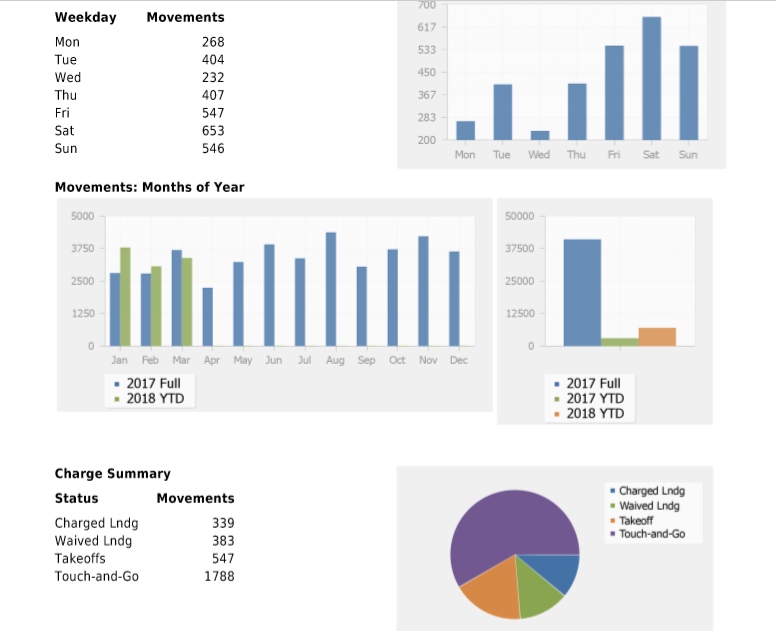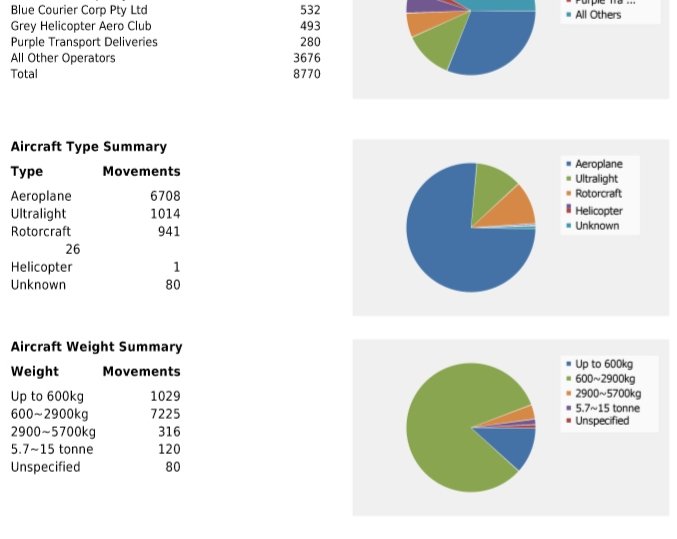
What Risk Related services does 'Aimm' provide?
Risk Management requires complete Movement Tracking and Reporting, so that the Management can show they are considering all the activity. With over 99% detection of reporting of ALL movements 24 / 7 / 365, Aimm provides this and reports the data needed to:
- Pro-actively minimise risk
- Take practicable steps to ensure the Health and Safety of Aviators, Staff, Contractors, and the Public
- In event of an Incident, be able to investigate effectively and mitigate the possibility of a recurance
- Have the hard evidence of these points in event of legal challenge
Airports have many specific dangers... turning propellors, landing aircraft, heavy machinery.
At small Airfields, an Aero Club or local Operator often does a good job of looking after the day to day management. However, the ultimate responsibility, and Liablilty, lies with the owner of the Airport Land... who must be able to show that they were aware of changing levels of activity and that Aviation knowledgeable people had considered this and taken whatever steps were necessary to ensure ongoing Health and Safety.
Aerodromes (Airports and Airfields) have their own very specific set of regulations, and just 'Leaving it to the Club' is only adequate if the Land Owner can show they are supervising to make certain that 'The Club' is doing what it should.
"Aviation need not be dangerous, but is very unforgiving of mistakes."
How does AIMM gather and present the Data?
For every movement (not just revenue generating movements), Aimm identifies: the time, date, the specific aircraft call sign or flight number, aircraft weight, type of aircraft, aircraft operator, type of movement (Takeoff / Landing / Touch And Go), and runway or helipad. This data is reported in several different forms for different uses...

DASHBOARD REPORT: The month's activity in graphical form for Managers,
Board members, and H&S Officer, collating and summarising the numbers and types of aircraft (planes, helicopters, gliders etc), their weights, runway used, day or night, and day of week. Comparison graphs show numbers of movements year-on-year and year-to-date. From Aimm's Dashboard Report it is usually obvious if the movement types or volume have changed significantly, which would alert the Management/Board to review procedures to satisfy themselves that they are still appropriate.
MOVEMENT / BILLING REPORT: A .CSV data file with the exact details of every movement by time and date, identifying the aircraft registration, weight, runway used, its operator with their full name and address from the official register, flight number and actual aircraft that flew the sector. Normally sent to the accounts-receivable dept of the Airport to be importing into the Airport's existing billing system for fully automated billing of Landing Fees.
These files can also be viewed in a spreadsheet (movement page /
archives / spreadsheet) to 'drill down' and identify who is doing what, and when.
VOICE RADIO CALL and ADSB POSITION ARCHIVES: The achives are a valuable resource in event of an incident and have prevented several Aimm client airports being 'held accountable' for incidents that their procedures did NOT cause. Aimm records ALL voice calls and ADSB positions... whether they generated a movement or were distant aircraft transitting the airspace and not landing. These can be retrieved for any period from the last few minutes back for at least three years. After a 'Loss of Separation' or other incident, different pilots sometimes have very different recollections of who said what, from where, at what time. Playing back the voice calls (which are timestamped to within two seconds) and plotting the ADSB positions (which show the positions to within a few meters), usually enables the Safety Committee or Official Investigators to resolve the cause and make appropriate recommendations for preventing a recurrance.

Safety Committee?
There are many benefits for an Airport/Airfield in establishing a Safety Committee. From the smallest Private Airfield to the largest International Airport, there will be complaints, risks, and Incidents of greater or lesser importance. Ideally the Safety Committee should have from 6 to 8 members, with a representative from each main type of activity.... e.g. one Flight Instructor, one low-hours Recreational Pilot, one Skydiver or Glider pilot, one Engineer, one representative of the Airport Land owner, etc. Often one person can wear several 'hats', so long as the full range of experience is represented.
They should meet regularly (in person or electronically) to review the general operations and satisfy themselves that the procedures and equipment are still appropriate for the changing levels of each type of activity. Their aviation expertise will also be useful to the Aerodrome management for Regulatory Compliance.
The Safety Committee should meet in person if a serious incident occurs... to discuss, investigate and recommend any changes to procedures or equipment thought necessary. If the Safety Committee is made up of experts in various types of Aviation, their collective knowledge is available to the Airport Management. This is especially valuable for Council Airports if the Council Officer in Charge does not have an Aviation background themselves. The OiC can refer any requests, complaints or concerns to the Safety Committee for a recommendation and this in itself is evidence that they are taking 'practicable steps' to safeguard the pilots, contractors and public.
-- If the Safety Committee decides that nothing needs to be done, that is a complete response to an incident, with the Aviation Authorities and others knowing that the incident has been taken seriously and carefully considered by experts.
-- If the Safety Committee recommends changes to equipment, the OiC has evidence that funding
may be needed to mitigate a risk.
-- If they recommend changes to Operational Procedures for Aviators, the committee will know how to promulgate this information. Most Aviators will readily accept a recommendation from a expert committee of their peers, so it does not fall to the OiC to
convince a group of perhaps sceptical aviators that changes are
needed.
Aimm's Services to Airports
Aimm monitors ALL movements and captures better than 99% of relevant Takeoffs, Landings, Touch-and-Goes at most Airports:
- Airside Personnel Tracker: Who is Airside? Where did they go? When?
- Landing Fees: Cost Effective Billing of Fees
- ADSB, Reports, Statistics and full Data for effective management and reporting
- Regulatory Compliance including CASA (Australia) and CAA (NZ) Part 139 Reporting
- Risk Management, Health and Safety, Incident Investigation
- Complaint Resolution and Noise Management
- Funding for Airports, Revenue generation, Grant Applications, Airport Master Plans.